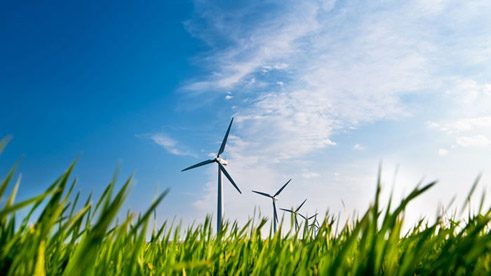Climate protection
The energy transition is on track

Germany is the land of the “Energiewende”. The goals are an ambitious climate protection programme and an exit from nuclear power. Renewables are already the most important source of electricity.
“German Energiewende” – the word has already found its way into English and has good chances of soon becoming as familiar as “kindergarten”, “Octoberfest” and “bratwurst”. Germany has embarked on an ambitious revamping of its energy system that is attracting attention worldwide – abandoning nuclear power and fossil fuels in favour of renewable energy sources such as solar, wind, hydroelectric and biomass.
The transition began in the year 2000. The Federal Government at the time, an SPD-Greens coalition, set in motion the country’s gradual exit from nuclear power and began promoting green electricity through its Renewable Energies Act (EEG), which has since been adopted by many other countries. Following Japan‘s Fukushima nuclear disaster in 2011, the governing CDU/CSU-FDP coalition reaffirmed the previous government’s energy transition policy. In one fell swoop, Germany shut down the eight oldest of the country’s 17 nuclear reactors – a move, incidentally, that was approved across party lines. Today, Germany’s climate and energy goals are reducing carbon emissions by 40 per cent by 2020 compared with 1990 levels and increasing the share of green electricity in total power consumption to between 40 and 45 per cent by 2025.
Substantial progress
The targets are ambitious but – according to current assessments – quite feasible. In the important electricity generation sector, a milestone was achieved in 2014, with renewables becoming the principal energy source in the power mix for the first time. They reached a share of 25.8 per cent, relegating lignite to second place (25.6 per cent). Hard coal followed with 19 per cent, then nuclear power (15.9 per cent) and natural gas (9.6 per cent). The share of nuclear energy in the mix – which stood at over 30 per cent prior to Fukushima – has been virtually halved. And it will continue to drop significantly as the remaining nine nuclear power plants are gradually shut down by 2022. If green energy sources continue to grow as planned, they will not only be able to replace the nuclear capacities being lost but also further reduce carbon dioxide emissions.Emissions of the greenhouse gas carbon dioxide in Germany are currently around 25 per cent below 1990 levels. That’s mainly thanks to German reunification, which triggered the collapse of inefficient industries in the former GDR, and government promotion of renewable energy. Following a critical rise in emissions in 2012 and 2013 – the result of particularly cold winters and an increase in coal-based power generation due to the low cost of coal – Germany is now back on track. In 2014, carbon dioxide emissions fell again significantly – by around five per cent – compared with 2013.
Nevertheless, to reach the 2020 carbon dioxide target of minus 40 per cent, even greater efforts will be required. According to the Federal Environment Ministry, existing measures will result in a reduction of 35 per cent at the most. That’s why the Federal Government adopted a national Climate Action Programme 2020 in late 2014 that is designed to bridge the gap. A raft of measures are planned in various sectors including industry, agriculture, transport, waste management, construction and housing, power plants and emissions trading. The biggest reduction is to be achieved by the energy-oriented refurbishment of old buildings. Also, more coal-fired power plants are to be decommissioned than previously planned. It’s uncertain, though, whether future green energy expansion targets can be met. In 2014, the increase in solar energy capacity fell short of the Federal Government’s expectations.
Broad approval for nuclear exit
Germany’s energy transition and nuclear exit policy enjoys broad public approval. According to a representative survey conducted by the Allensbach Institute in mid-2014, the approval rate remains steady at 70 per cent. Only 15 per cent of those surveyed think Germany is on the wrong path. Other polls have yielded approval rates of as high as 90 per cent. This positive mood is remarkable given the fact that there was fierce public debate on the energy transition in 2013 and 2014. The discussion focused on two points in particular. The first was the rapid rise in electricity prices due to the promotion of green power, though this increase did not continue in 2015. The second concerned plans to build new high-tension power lines across the country. These are designed to ensure better distribution of wind-generated electricity, most of which is produced in the north of the country. However, they have caused discontent among people living close to the proposed routes of transmission lines.Many observers at the time didn’t rule out a shift in the public mood. The fact that this didn’t happen suggests that most of Germany’s citizens haven’t lost sight of the energy transition’s long-term goal: an energy supply system that minimises nuclear and climate risks as far as possible.